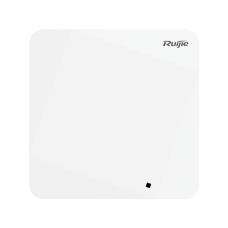RG-SAP750-SP, Wi-Fi 5 Dual-Radio 1.167 Gbps Cost-Effective Indoor Access Point Best Price In Dubai, UAE.
Availability:
In Stock
Indoor network scenarios in the higher education, medical industry, government and commerce
Highlight Features
- Cost-effective high-speed at 1.167 Gbps
- PoE and DC power supply, flexible deployment
- WIS unified cloud management for easy O&M
Description
Key Specification
Product Overview
The RG-SAP750-SP is a Wi-Fi 5 wireless access point that integrates dual radios, high performance, and enterprise-grade encryption technology. Due to the hybrid cloud management mode and high-speed access design, it is suitable for flexible deployment in high-quality network scenarios, such as classroom, dormitory, and office scenarios in the education industry, production workshop and warehouse scenarios in the manufacturing industry, and outpatient clinics and mobile ward rounds scenarios in the medical industry.
Product Highlights
Cost-effectiveness and High Speed
Dual-band design (2.4 GHz + 5 GHz), four spatial streams, up to 1.167 Gbps peak data rate, and throughput increased compared to traditional 802.11n wireless mode, providing users with a high-speed wireless access experience
RF power adjustment and intelligent channel allocation to solve the problems such as co-channel interference and adjacent channel interference, thereby improving network transmission efficiency and stability
Intelligent networking
Local and cloud management modes, and intelligent wireless network optimization, reducing TCO and maximizing ROI Radio Resource Management (RRM) technology, avoiding signal interference between APs and between APs and interference devices, and improving user experience IEEE 802.11k/v/r support and roaming stickiness optimization, achieving seamless user roaming Intelligent local forwarding technology used to forward data that is sensitive to delay and requires real-time high-performance transmission through a wired network, greatly reducing the traffic pressure on ACs
High Security and Reliability
Encryption and authentication technologies including Wi-Fi Protected Access 3 (WPA3), enhanced open security, 802.1X, MSCHAPv2 and Private Pre-shared Key (PPSK), enhancing data security
Network Foundation Protection Policy (NFPP) used to rate-limit or isolate attack flows to restore the network
Dynamic Frequency Selection (DFS), optimizing the use of available RF spectrum to prevent radar channel interference
Cyclic Delay/Shift Diversity (CDD/CSD), Maximum Ratio Combining (MRC), Space-Time Block Coding (STBC), and Low-Density Parity Check (LDPC), improving the signal quality, signal receiving, and reliability and performance of data transmission
Intelligent identification and monitoring, multicast-to-unicast conversion, and other features, enhancing network security and reliability
Specifications
Hardware Specifications
| Hardware Specifications |
RG-SAP750-SP |
| 802.11n |
Four spatial streams ● Radio 1 – 2.4 GHz: 2x2 MIMO, two spatial streams ● Radio 2 – 5 GHz: 2x2 MIMO, two spatial streams Channels: ● Radio 1 – 2.4 GHz: 20 MHz and 40 MHz ● Radio 2 – 5 GHz: 20 MHz and 40 MHz Combined peak data rate: 600 Mbps ● Radio 1 – 2.4 GHz: 6.5 Mbps to 300 Mbps (MCS0 to MCS15 ) ● Radio 2 – 5 GHz: 6.5 Mbps to 300 Mbps (MCS0 to MCS15 ) Radio technologies: Orthogonal Frequency-Division Multiplexing (OFDM) Modulation types: BPSK, QPSK, 16-QAM, 64-QAM Packet aggregation: ● Aggregate MAC Protocol Data Unit (A-MPDU) ● Aggregate MAC Service Data Unit (A-MSDU) Dynamic Frequency Selection (DFS) Cyclic Delay/Shift Diversity (CDD/CSD) Maximum Ratio Combining (MRC) Space-Time Block Coding (STBC) Low-Density Parity Check (LDPC) Transmit beam-forming (TxBF) |
| 802.11ac |
Two spatial streams ● Radio 2 – 5 GHz: 2x2 MIMO, two spatial streams Channels: ● Radio 2 – 5 GHz: 20 MHz, 40 MHz, and 80 MHz Combined peak data rate: 867 Mbps ● Radio 2 – 5 GHz: 6.5 Mbps to 867 Gbps (MCS0 to MCS9) Radio technologies: Orthogonal Frequency-Division Multiplexing (OFDM) Modulation types: BPSK, QPSK, 16-QAM, 64-QAM, 256-QAM Packet aggregation: ● Aggregate MAC Protocol Data Unit (A-MPDU) ● Aggregate MAC Service Data Unit (A-MSDU) Dynamic Frequency Selection (DFS) Cyclic Delay/Shift Diversity (CDD/CSD) Maximum Ratio Combining (MRC) Space-Time Block Coding (STBC) Low-Density Parity Check (LDPC) Transmit beam-forming (TxBF) |
| Antenna |
Wi-Fi ● 2.4 GHz: two built-in omnidirectional antennas, the max. antenna gain is 4.3 dBi. ● 5 GHz: two built-in omnidirectional antennas, the max. antenna gain is 5.7 dBi. |
| Port |
1 x 10/100/1000Base-T RJ45 Ethernet port with auto-negotiation 1 x RJ45 console port (serial console port) |
| Status LED |
1 x multi-color system status LED ● AP power-on status ● Software initialization status ● Wireless user online status |
| Button |
1 x Reset button ● Press the button for shorter than 2 seconds. Then the device restarts. ● Press the button for longer than 5 seconds. Then the device restores to factory settings. |
| Dimensions (W x D x H) |
Main unit: 194 mm x 194 mm x 37 mm (7.64 in. x 7.64 in. x 1.46 in.) Shipping: 460 mm x 360 mm x 242 mm (18.11 in. x 14.17 in. x 9.53 in.) |
| Weight |
Main unit: 0.42 kg (1.0 lbs) Mounting bracket: 0.07 kg (0.2 lbs) Shipping: 0.87 kg (2.0 lbs) |
| Mounting |
Wall/Ceiling-mount (a mounting bracket is delivered with the main unit) |
| Lock option |
Kensington lock and securing latch |
| Input power supply |
The AP supports the following two power supply modes: ● 12 V DC/1.5 A power input over DC connector: The DC connector accepts 2.1 mm/5.5 mm center-positive circular plug. A DC power supply needs to be purchased independently. ● PoE input over LAN 1: The power source equipment (PSE) complies with IEEE 802.3af standard (PoE). Note: If both DC power and PoE are available, DC power is preferred. |
| Power consumption |
Maximum power consumption: 12.95 W ● DC power: 12.95 W ● 802.3af (PoE): 12.95 W |
| Environment |
Storage temperature: –40°C to +70°C (–40°F to +158°F) Storage humidity: 5% RH to 95% RH (non-condensing) Operating temperature: –10°C to +50°C (14°F to 122°F) Operating humidity: 5% RH to 95% RH (non-condensing) At an altitude between 3,000 m (9,842.52 ft.) and 5,000 m (16,404.20 ft.), every time the altitude increases by 166 m (546 ft.), the maximum temperature decreases by 1°C (1.8°F). |
| Mean Time Between Failure (MTBF) |
200,000 hours (22 years) at the operating temperature of 25°C (77°F) |
| System memory |
128 MB DRAM, 32 MB flash |
| Transmit power |
2.4 GHz ● Max. transmit power: 26 dBm (392 mW) 5 GHz ● Max. transmit power: 26 dBm (392 mW) Note: The transmit power adjusted in percentage. The transmit power is limited by local regulatory requirements. |
The following table lists the radio frequency performance of Wi-Fi including different frequency bands, protocols, and date rates. It is country-specific, and Ruijie Networks reserves the right of interpretation.
| Radio Frequency Performance |
RG-SAP750-SP |
||
| Frequency Band and Protocol |
Data Rate |
Max. Transmit Power per Transmit Chain |
Max. Receive Sensitivity per Receive Chain |
| 2.4 GHz 802.11b |
1 Mbps |
23 dBm |
–91 dBm |
| 2 Mbps |
23 dBm |
–89 dBm |
|
| 5.5 Mbps |
23 dBm |
–88 dBm |
|
| 11 Mbps |
23 dBm |
–85 dBm |
|
| 2.4 GHz 802.11g |
6 Mbps |
23 dBm |
–89 dBm |
| 24 Mbps |
23 dBm |
–80 dBm |
|
| 36 Mbps |
21 dBm |
–76 dBm |
|
| 54 Mbps |
19 dBm |
–70 dBm |
|
| 2.4 GHz 802.11n (HT20) |
MCS0 |
21 dBm |
–83 dBm |
| MCS7 |
19 dBm |
–65 dBm |
|
| 2.4 GHz 802.11n (HT40) |
MCS0 |
21 dBm |
–80 dBm |
| MCS7 |
18 dBm |
–62 dBm |
|
| 5 GHz 802.11a |
6 Mbps |
23 dBm |
–89 dBm |
| 24 Mbps |
23 dBm |
–80 dBm |
|
| 36 Mbps |
21 dBm |
–76 dBm |
|
| 54 Mbps |
19 dBm |
–70 dBm |
|
| 5 GHz 802.11n (HT20) |
MCS0 |
20 dBm |
–83 dBm |
| MCS7 |
18 dBm |
–65 dBm |
|
| 5 GHz 802.11n (HT40) |
MCS0 |
19 dBm |
–80 dBm |
| MCS7 |
18 dBm |
–62 dBm |
|
| 5 GHz 802.11ac (VHT20) |
MCS0 |
20 dBm |
–82 dBm |
| MCS9 |
17 dBm |
–57 dBm |
|
| 5 GHz 802.11ac (VHT40) |
MCS0 |
19 dBm |
–79 dBm |
| MCS9 |
16 dBm |
–54 dBm |
|
| 5 GHz 802.11ac (VHT80) |
MCS0 |
19 dBm |
–76 dBm |
| MCS9 |
16 dBm |
–51 dBm |
|
Software Specifications
Basic Functions
| Basic Function |
RG-SAP750-SP |
| Applicable software version |
AP_RGOS 11.1(9)B1P37 or later |
| WLAN |
|
| Max. number of associated STAs |
256 ● Radio 1: 2.4 GHz, up to 100 connected STAs ● Radio 2: 5 GHz, up to 156 connected STAs |
| Max. number of BSSIDs |
32 (up to 16 BSSIDs per radio) |
| Max. number of WLAN IDs |
16 Max. number of associated STAs per WLAN: 256 |
| STA management |
SSID hiding Band steering Each SSID can be configured with the authentication mode, encryption mechanism, and VLAN attributes independently. Remote Intelligent Perception Technology (RIPT) Intelligent load balancing based on the STA quantity or traffic |
| STA limiting |
SSID-based STA limiting Radio-based STA limiting |
| Bandwidth limiting |
STA/SSID/AP-based rate limiting |
| CAPWAP |
IPv4/IPv6 CAPWAP CAPWAP through NAT MTU setting and fragmentation over CAPWAP tunnels |
| Data forwarding |
Centralized and local forwarding |
| Wireless roaming |
Layer 2 and Layer 3 roaming |
| Wireless locating |
MU and TAG device locating |
| Security and Authentication |
|
| Authentication and encryption |
Remote Authentication Dial-In User Service (RADIUS) PSK , web, 802.1x and MSCHAPv2 authentication SMS-based and QR code-based guest authentication, and MAB authentication (used with RG-WS series wireless controller) Data encryption: WEP (64/128 bits), WPA-TKIP, WPA-PSK, and WPA2-AES |
| Data frame filtering |
Allowlist, static blocklist, and dynamic blocklist |
| WIDS |
User isolation Rogue AP detection and containment |
| ACL |
IP standard ACL, MAC extended ACL, IP extended ACL, and expert-level ACL Time range-based ACL Inbound ACL based on Layer 2 interfaces Inbound ACL based on Layer 3 interfaces Inbound ACL based on wireless interfaces Dynamic ACL assignment based on 802.1X authentication (used with the AC) |
| CPP |
CPU Protect Policy (CPP) |
| NFPP |
Network Foundation Protection Policy (NFPP) |
| Routing and Switching |
|
| MAC |
Static and filtered MAC addresses MAC address table size: 1,024 Max. number of static MAC addresses: 1,024 Max. number of filtered MAC addresses: 1,024 |
| Ethernet |
Jumbo frame length: 1,518 Ethernet II IEEE802.1p and IEEE802.1Q |
| VLAN |
Interface-based VLAN assignment Max. number of CVIs: 40 Max. number of SVIs: 40 Max. number of VLANs: 4,094 VLAN ID range: 1–4,094 |
| ARP |
ARP entry aging, proxy ARP, and IP address conflict detection between downlink users Max. number of ARP entries: 1,024 ARP check |
| IPv4 services |
Static and DHCP-assigned IPv4 addresses Max. number of IPv4 addresses configured on each Layer 3 interface: 200 NAT, FTP ALG and DNS ALG |
| IPv6 services |
IPv6 addressing, Neighbor Discovery (ND), ICMPv6, IPv6 ping, IPv6 tracert Max. number of IPv6 addresses configured on each Layer 3 interface: 16 |
| IP routing |
IPv4/IPv6 static route Max. number of static IPv4 routes: 1,024 Max. number of static IPv6 routes: 1,000 |
| Multicast |
Multicast, Multicast-to-unicast conversion |
| VPN |
PPPoE client |
| Network Management and Monitoring |
|
| Network management |
SNMPv1/v2c/v3 Fault detection and alarm Information statistics and logging |
| Network management platform |
Web management (Eweb) |
| User access management |
Console, Telnet, SSH, FTP client, FTP server, and TFTP client |
| Switchover among Fat, Fit, and cloud modes |
When the AP works in Fit mode, it can be switched to Fat mode through an AC. When the AP works in Fat mode, it can be switched to Fit mode through the console port or Telnet mode. When the AP works in cloud mode, it can be managed through Ruijie Cloud. |






Reviews (0)